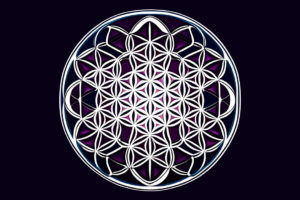 Sacred Geometry – The Math Behind Creation (Shared from Mu the Motherland.)
Sacred Geometry – The Math Behind Creation (Shared from Mu the Motherland.)
Sacred Geometry views geometric forms and patterns as having symbolic and spiritual significance. One of the most well-known symbols of sacred geometry is the flower of life, which consists of a series of interlocking circles that form a geometric pattern. This symbol has been found in many ancient cultures, including Egypt, India, and China, and is believed to represent the interconnectedness of all living things.
Geometric designs are intriguing in that our first reaction to them is usually, ‘Look how pretty.” However, as we tune into our inner perceptions through meditation, we experience the limitless encoded floral patterns that seed new life. At conception, the eight-cell division begins as one becomes two, two becomes four, and four becomes eight original cells—a cube—the same geometry that is used in the high-tech world which is based on the cubic crystal of quartz. So, rather than see the mechanical aspects of our lives as apart from us, we can reconcile with them to spur us on to greater heights.
In today’s world, many look upon religion as a series of mysterious, sacred beliefs. Throughout history, however, the material and spiritual worlds were often looked upon as the same. If we look again at the flower of life symbol there are 90 petals made from intersecting circles and 54 triangles between them, equaling 144, which is an important number in the calculation of the Ley lines of the earth’s grid that we considered in a prior posting.
The study of sacred geometry is not limited to ancient cultures and religions, however. It has also been embraced by modern scientists and mathematicians as a way of understanding the underlying patterns and structures of the universe. For example, fractal geometry, which involves the repetition of geometric patterns at different scales, has been used to model everything from the growth of plants to the behavior of financial markets.
In addition to its scientific and mathematical applications, sacred geometry is also used as a tool for personal and spiritual growth. Many people believe that meditating on sacred geometric symbols can help them connect with their inner selves and access higher states of consciousness. Others use sacred geometry as a way of creating a sacred space in their homes or workplaces, using geometric patterns and symbols to create a sense of harmony and balance.
Despite its many uses and applications, sacred geometry remains a mysterious and enigmatic system of beliefs. Its origins are shrouded in mystery, and its symbols and meanings have been interpreted in many different ways over the centuries. Nevertheless, it continues to fascinate and inspire people around the world, offering a glimpse into the hidden patterns and structures that underlie the universe we inhabit.
So, how do we tap into this cosmic flower? Think about how many holy and spiritual places that have utilized this mandala in their religious ceremonies. The list is endless: Sun masks of the Northcoast Indians, Vishnu mandalas of Nepal, Circular Krishna dances in India, Sun Disks in New Guinea, Navajo sand paintings, The Rose Window in Chartres Cathedral, Buffalo robe designs of the Plains Indians etc. – all examples of cultural uses for prayer, meditation, and celebration of life and death. There is no definitive way to tap into this common power source. Simply draw the symbol, wear the symbol, or incorporate it into your personal spaces. Remember everything is energy and we can tap into those energies unique to our path and use them to follow our individually designed bliss. Enjoy!
ShareJUN
2023


About the Author:
Elaine Webster writes fiction, creative non-fiction, essays and poetry from her studio in Las Cruces, New Mexico—in the heart of the Land of Enchantment. “It’s easy to be creative surrounded by the beauty of Southern New Mexico. We have the best of everything—food, art, culture, music and sense of community.”